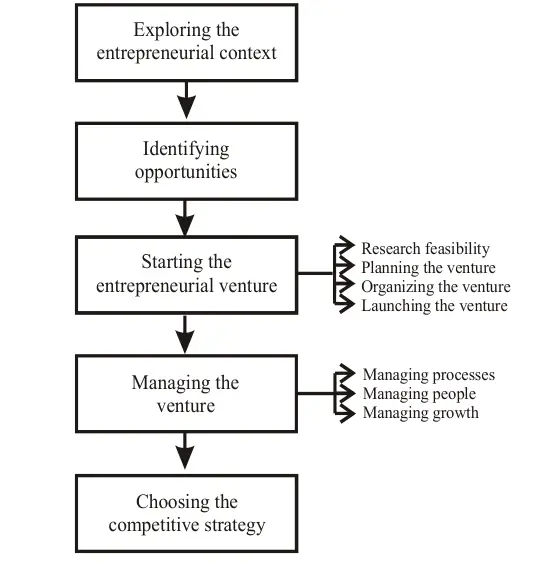The entrepreneurial process is a leadership function that centers around the dynamics of entrepreneurial growth and change. It is a process comprising several distinct stages.
Table of Contents
Entrepreneurial Process
From exploring the various aspects of the entrepreneurial context to identifying opportunities, starting and managing the entrepreneurial venture, and choosing the competitive strategy in action. Let’s look at each of these decisions and activities and the following are the stages of the entrepreneurial process:

Exploring Entrepreneurial Context
Why is it important to look at the entrepreneurial context? Because the context determines the “rule” of the game and what decisions are likely to be successful. The context includes the realities of the new economy, society’s laws and regulations that compose the legal environment, and the realities of the changing world of work.
Entrepreneurs should be aware of the context within which entrepreneurial decisions are made. Only through exploring the context can entrepreneurs discover the untapped opportunities and competitive advantage(s) that may lead to the development of a potentially successful entrepreneurial venture.
Identifying Opportunities
A crucial aspect of the entrepreneurial process is identifying opportunities. What are opportunities? These opportunities are positive external trends or changes that provide unique and distinct possibilities for innovating and creating value. There are thousands of opportunities available to an entrepreneur.
Some of them are not real opportunities with high potential. Some opportunities have growth prospects. Entrepreneurs search for profitable ones and then select an attractive business opportunity.
However, just identifying an opportunity isn’t enough. The entrepreneurial process also involves pinpointing a possible competitive advantage. A competitive advantage is what sets an organization apart; it’s an organization’s competitive edge. Having a competitive advantage is crucial for an organization’s long-term success and survival.
Starting Venture
Once entrepreneurs have explored the external context and identified possible opportunities and competitive advantage(s), they must look at the issues involved with actually starting up their entrepreneurial venture.
Included in this phase of the entrepreneurial process are the following activities; researching the feasibility of the venture, planning the venture, organizing the venture, and launching the venture. Financial, physical, and managerial resources must be collected to launch the venture.
Managing Venture
Once the entrepreneurial venture is up and running the next step in the entrepreneurial process is managing the venture. An entrepreneur also must effectively manage the venture by managing processes, managing people, and managing growth. This requires the talents of leading, decision-making, executing, controlling, and various managerial skills.
Choosing Competitive Strategy
Once the entrepreneurial venture is up and running, the last step is to choose the competitive strategy. Peter Drucker mentions the following specific entrepreneurial strategies. These are
- Being fastest with the most.
- Creative imitation.
- Entrepreneurial judo.
- Finding and occupying a specialized ecological niche.
- Changing values and characteristics by creating utility, by delivering what represents true value to the customer, by adopting the customer’s social and economic reality, and by appropriate pricing.
FAQs About the Entrepreneurial Process
What are the stages of the entrepreneurial process?
The stages of the entrepreneurial process are:
1. Exploring Entrepreneurial Context
2. Identifying Opportunities
3. Starting Venture
4. Managing Venture
5. Choosing Competitive Strategy.





